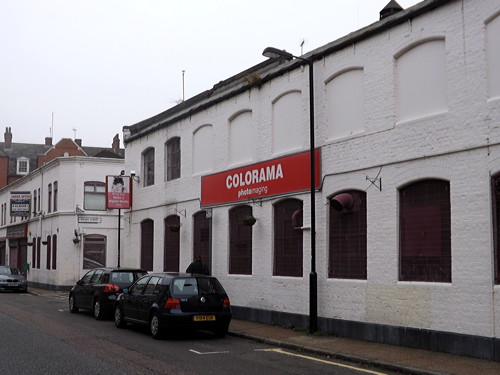Demolition of Colorama buildings approved by Southwark councillors
A Southwark planning sub-committee has approved a proposal to demolish the former Colorama buildings on Lancaster Street and replace them with 39 new homes.

The former Colorama photographic processing centre includes two buildings – one Victorian, one 20th century – either side of the junction of Lancaster Street and Library Street.
The committee approved the proposal by four votes to one at a meeting on Wednesday night.
The redevelopment scheme has been designed by Union Street-based Alan Camp Architects.
"The proposed buildings are of contemporary design and are considered to be of high architectural quality using materials to match the context of surrounding buildings," said planning officer Michele Sterry.
Conservation officer Norman Brockie told councillors that the buildings had a limited aesthetic and historical value.
"They have a certain utilitarian charm," he said. "But by no means do they have an architectural quality that would justify listing."
The committee heard from Charlotte Glazier, of the newly founded Blackfriars Preservation Society, who highlighted the 400 signatures on a petition calling for the retention of the buildings.
"These buildings date from 1882 and are representative of the industrial heritage of the area between Elephant & Castle and the river," said Ms Glazier.
"We feel there are strong grounds to refuse planning permission that are grounded both locally and in national planning policy."
She added: "More generally, late Victorian buildings in the area are being picked off one by one at an ever-increasing speed. The acceleration of this loss is staggering and causing great harm to the character of the area. The tide needs to turn now.
"These buildings should be preserved for future generations to enjoy and imaginative reuse options should be explored and developed."
Asked by committee member Cllr Barrie Hargrove to justify the retention of the buildings when redevelopment would bring much-needed affordable housing, fellow objector Phoebe Greenwood said: "It shouldn't be an either/or thing. No-one's against new housing – especially affordable housing – or good new architecture. It just shouldn't be at the expense of this particular site."
Architect Alan Camp told councillors: "We're not architects who do knee-jerk reactions to buildings just to knock them down."
He argued that the quality of the current buildings was "very low on any sort of scale".
"I go past the buildings a lot," he said. "The main building has no merit whatsoever. It's post-Second World War. The other building is at the end of the 19th century and you have to draw a line somewhere and say that there are certain things that are not worth keeping."
The meeting also heard from local resident Tim Cochrane who spoke in favour of the development. He said that the current buildings are in disrepair and had been occupied by squatters who had "scared" his wife and nanny.
"Everyone I know locally is in favour of the scheme," he said.
Cathedrals ward councillor Geoffrey Thornton addressed the committee in support of objectors.
"The truth is that these buildings are some of the last examples of the light industrial units that were once spread across the whole neighbourhood but which are now disappearing at an alarming rate," he said.
Sub-committee chair Cllr Victoria Mills moved that planning permission be granted, noting that the scheme is of "high quality design" and would provide "much-needed" affordable housing.
Committee member Mark Gettleson said he sympathised with the objectors but could see no valid grounds to refuse the application.
"If this development was on an empty piece of land, everyone would be in favour," he said.
Cllr Adele Morris, the only committee member to vote against the scheme, warned that the speed of development in the north-west of the borough risked compromising the area's distinctive character.
"Everything that makes people want to live in Cathedrals ward is about these quirky industrial units which do have an intrinsic and historical value, even though the the conservation team in Southwark may not think that they do," she said.
Comments
Share
The SE1 website is supported by people like you
More to read
Related forum discussions
- Colorama demolition under way
- Just a Pic of Squatters taking over the disused office building on Joan street
- Library Street Social Centre Collective
- Film Developing
- Update on Colorama (Lancaster Street) Planning Application
- Has the Bell Pub Webber Street been turned into squat?
- Hill House Blackfriars Road
- 35mm photo processing and printing - any recommendations please
Follow us
Email newsletter
For the latest local news and events direct to your inbox every Monday, you need our weekly email newsletter SE1 Direct.

